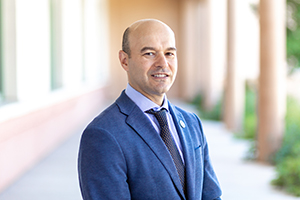Recent News
UNM joins Brown University in national institute focused on intuitive, trustworthy AI assistants
August 6, 2025
UNM Engineering team wins ASEE best paper for work on first-year engineering course
July 17, 2025
New director will enhance interdisciplinary engineering learning opportunities
July 2, 2025
Final SIRI cohort visits UNM campus
June 30, 2025
News Archives
Right on track: Researchers use new tech to improve railroad safety
February 14, 2025 - By Carly Bowling

Railroads may bring to mind images of the Old West and the Industrial Revolution, but researchers at The University of New Mexico School of Engineering are working to bring new, cutting-edge technologies to even the smallest and most remote railroad systems as part of a national center led by Penn State University and funded by the Federal Railroad Administration (FRA).
The new Rail Center for Research Enhancing Short Line Transportation (CREST), established by a $6.8 million grant from the Consolidated Rail Infrastructure and Safety Improvements (CRISI) Program and set to begin this fall, proposed 10 research projects by several universities in partnership with railroads. Participating universities include Penn State, Kansas State University, University of Texas, Auburn University, University of South Carolina, and UNM.
Railroad companies own their tracks and are responsible for maintaining them, a task much easier for the largest companies, known as Class Ones. The new project aims to help short lines –– the smallest railroad lines that operate as small businesses–– become safer and more profitable by developing low-cost sensors, augmented reality and artificial intelligence that can be used to identify pieces of track that may need special attention, informing the prioritization of repair or maintenance decisions.

Fernando Moreu, associate professor in the Gerald May Department of Civil, Construction and Environmental Engineering, will lead UNM’s work through his Smart Management of Infrastructure Lab (SMILab). He worked in railroad bridge infrastructure for more than a decade before pivoting to academic research.
“The Class One railroads are already using AI, but they have way more resources than the short lines, so we want to make AI accessible to them too. If you collect millions of data points as a big railroad, you can bring AI into your operations, but short lines don’t have that,” Moreu said. “We’re trying to make accessible for the short lines the same technical benefits that exist for larger railroads.”
Finding spots of decay early can make track maintenance less expensive and improve overall safety in the long run, but to do it effectively takes feedback from railroad managers, an understanding of computer science and expertise in engineering. Lisa Losada Rojas, assistant professor in the Gerald May Department of Civil, Construction and Environmental Engineering, is a co-principal investigator on the project.

“Our main focus is that our work is very interdisciplinary,” Losada Rojas said. “I am focused on transportation and through my research I hope to make communities healthier through transportation solutions. The goal is to make people healthier, society healthier, and our infrastructure healthier and more resilient for the future.”
UNM’s project will examine how low-cost sensors and neuromorphic cameras can make maintenance more efficient for small railroad companies. The Low-cost Efficient Wireless Intelligent Sensors (LEWIS), a $50 accelerometer-based technology developed in the SMILab, can be placed on trains to monitor vibrations and detect general areas that should be inspected for repair. The low-cost LEWIS sensor offers an incredibly accessible option for short lines. Neuromorphic cameras are a more expensive option, with a price tag of around $7,000, but are far more advanced and offer greater potential for integration with artificial intelligence.
Wyatt Saeger, a Civil Engineering master’s student, works on neuromorphic cameras in the SMILab and is excited to see their potential realized in railroad systems. Saeger is currently working in MIMO research in a project funded by Sandia National Laboratories and is excited to see fundamental research impacting the real world.
“There is so much more we can work on and develop that hasn’t been done before and I’m excited to start getting images at high speeds,” he said.
The cameras attach to railcars and record the track, ballasts and spikes as the train travels over them. Where a sensor can tell an operator the general area that should be inspected based on vibration, a neuromorphic camera can show exactly what area may need repair. The team will use the millions of data points collected by the neuromorphic cameras over time to train an AI system to detect how the railroad components decay over time and when an operator should invest in repairs, preventing potentially dangerous situations in the future.
Ali Mohammadkhorasani is a Ph.D. Candidate in Moreu’s lab studying how AI and augmented reality can be used to improve decision-making by railroad inspectors, who may each provide different reports about which areas are most in need of repair. As part of the Penn State collaboration, researchers will work closely with railroad managers to determine what AI and AR systems are needed most. He has worked for the Southern Plains Center of Transportation recently and has experience working directly with railroad bridge inspectors also funded by the FRA in the past.
“Using these systems to record the width of a crack is not that important, but identifying a crack that inspectors don’t see is very important,” Mohammadkhorasani said, adding that they would like the system to help show inspectors the largest and fastest-growing cracks.
Eventually, augmented reality could help railroad inspectors visualize structural problems that may be challenging to see with the human eye, improving the reliability of structural reports.
Learn more about other research projects happening in the SMILab online.
